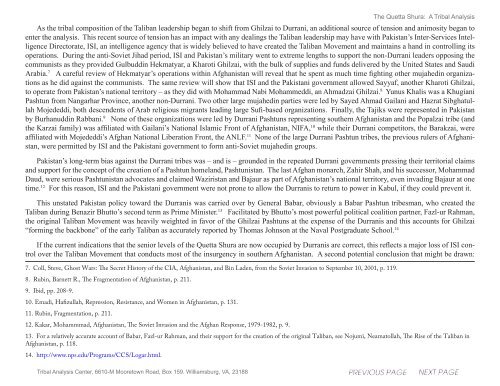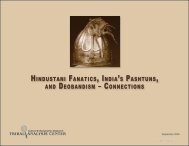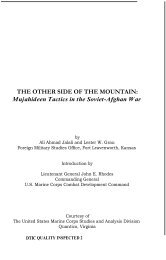THE QUETTA SHURA: A TRIBAL ANALYSIS - Tribal Analysis Center
THE QUETTA SHURA: A TRIBAL ANALYSIS - Tribal Analysis Center
THE QUETTA SHURA: A TRIBAL ANALYSIS - Tribal Analysis Center
You also want an ePaper? Increase the reach of your titles
YUMPU automatically turns print PDFs into web optimized ePapers that Google loves.
The Quetta Shura: A <strong>Tribal</strong> <strong>Analysis</strong>As the tribal composition of the Taliban leadership began to shift from Ghilzai to Durrani, an additional source of tension and animosity began toenter the analysis. This recent source of tension has an impact with any dealings the Taliban leadership may have with Pakistan’s Inter-Services IntelligenceDirectorate, ISI, an intelligence agency that is widely believed to have created the Taliban Movement and maintains a hand in controlling itsoperations. During the anti-Soviet Jihad period, ISI and Pakistan’s military went to extreme lengths to support the non-Durrani leaders opposing thecommunists as they provided Gulbuddin Hekmatyar, a Kharoti Ghilzai, with the bulk of supplies and funds delivered by the United States and SaudiArabia. 7 A careful review of Hekmatyar’s operations within Afghanistan will reveal that he spent as much time fighting other mujahedin organizationsas he did against the communists. The same review will show that ISI and the Pakistani government allowed Sayyaf, another Kharoti Ghilzai,to operate from Pakistan’s national territory – as they did with Mohammad Nabi Mohammeddi, an Ahmadzai Ghilzai. 8 Yunus Khalis was a KhugianiPashtun from Nangarhar Province, another non-Durrani. Two other large mujahedin parties were led by Sayed Ahmad Gailani and Hazrat SibghatullahMojededdi, both descendents of Arab religious migrants leading large Sufi-based organizations. Finally, the Tajiks were represented in Pakistanby Burhanuddin Rabbani. 9 None of these organizations were led by Durrani Pashtuns representing southern Afghanistan and the Popalzai tribe (andthe Karzai family) was affiliated with Gailani’s National Islamic Front of Afghanistan, NIFA, 10 while their Durrani competitors, the Barakzai, wereaffiliated with Mojededdi’s Afghan National Liberation Front, the ANLF. 11 None of the large Durrani Pashtun tribes, the previous rulers of Afghanistan,were permitted by ISI and the Pakistani government to form anti-Soviet mujahedin groups.Pakistan’s long-term bias against the Durrani tribes was – and is – grounded in the repeated Durrani governments pressing their territorial claimsand support for the concept of the creation of a Pashtun homeland, Pashtunistan. The last Afghan monarch, Zahir Shah, and his successor, MohammadDaud, were serious Pashtunistan advocates and claimed Waziristan and Bajaur as part of Afghanistan’s national territory, even invading Bajaur at onetime. 12 For this reason, ISI and the Pakistani government were not prone to allow the Durranis to return to power in Kabul, if they could prevent it.This unstated Pakistan policy toward the Durranis was carried over by General Babar, obviously a Babar Pashtun tribesman, who created theTaliban during Benazir Bhutto’s second term as Prime Minister. 13 Facilitated by Bhutto’s most powerful political coalition partner, Fazl-ur Rahman,the original Taliban Movement was heavily weighted in favor of the Ghilzai Pashtuns at the expense of the Durranis and this accounts for Ghilzai“forming the backbone” of the early Taliban as accurately reported by Thomas Johnson at the Naval Postgraduate School. 14If the current indications that the senior levels of the Quetta Shura are now occupied by Durranis are correct, this reflects a major loss of ISI controlover the Taliban Movement that conducts most of the insurgency in southern Afghanistan. A second potential conclusion that might be drawn:7. Coll, Steve, Ghost Wars: The Secret History of the CIA, Afghanistan, and Bin Laden, from the Soviet Invasion to September 10, 2001, p. 119.8. Rubin, Barnett R., The Fragmentation of Afghanistan, p. 211.9. Ibid, pp. 208-9.10. Emadi, Hafizullah, Repression, Resistance, and Women in Afghanistan, p. 131.11. Rubin, Fragmentation, p. 211.12. Kakar, Mohammmad, Afghanistan, The Soviet Invasion and the Afghan Response, 1979-1982, p. 9.13. For a relatively accurate account of Babar, Fazl-ur Rahman, and their support for the creation of the original Taliban, see Nojumi, Neamatollah, The Rise of the Taliban inAfghanistan, p. 118.14. http://www.nps.edu/Programs/CCS/Logar.html.<strong>Tribal</strong> <strong>Analysis</strong> <strong>Center</strong>, 6610-M Mooretown Road, Box 159. Williamsburg, VA, 23188
















